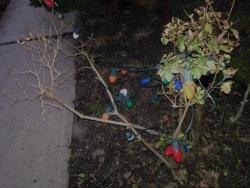Azaleas like well mulched, acidic soil with evenly moist soil. Periods of dry soil followed by moist soil and back to dry will cause parts of the plant to suffer and-or dry out. Acidic or hardwood mulch will help conserve soil moisture and is needed especially in the summer months when the azalea's very thin roots in the topmost 4" of the soil can quickly dry out. If that happens for long enough, you end with bare branches or worse, dead branches. You can confirm the status of these branches with your nails. Softly scratch the branches to see the cambium layer and determine if you see green there or not. If you see green, the branch is still alive and it m-a-y leaf out next Spring (not now, it is too late in the growing season for that).
Alkaline soil can make the leaves turn light green or yellowish, with the veins remaining dark green. This is called iron chlorosis: the azalea cannot absorb iron and the leaf colors change. You can add iron sulfate, garden Sulphur or iron-chelated liquids available at most plant nurseries to treat this soil condition.
The plant nurseries also sell a kit that you can use to test the soil for alkalinity but they may be out of stock now. Try one of these in Spring. They are el cheapo things, not accurate but, close enough for govmt work. If one indicates the soil is very alkaline, I would amend the soil, which is something you may have to do with some regularity. For example, I do that always in the Spring and sometimes in the Fall. The liquids resolve the problem faster than the solids but they both take several weeks to correct the problem. The labels will offer suggestions on how much to apply and how often. But I apply once in Spring only. Then again in the Fall if I see leaves yellowing on my camellias, hydrangeas or azaleas.
I do not see mulch in the picture so I would add some, about 3-4" up to the drip line. I am not exactly sure what the streaks on the leaves are/were though. Do you have a picture showing that (a close up of a leaf, say?)?
Luis
